Register to receive free access to all teacher materials.
Programming Language
Any language supported by Hummingbird Duo
Subjects
Math
Grades
9-12
Free Teacher Materials
In this lesson, you will be building a winch mechanism. Watch this video to see what it will look like.
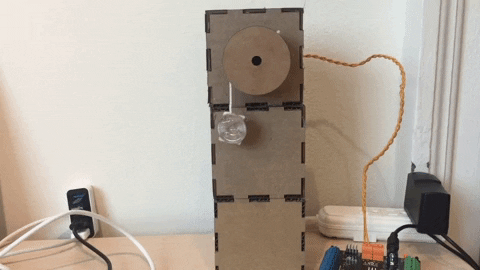
This mechanism has three parts:
- The winch is a cylinder attached to a motor that rotates it.
- The cable is wound around the winch. It is flexible and can be made of string, cord, or wire.
- The mass is attached to the end of the cable.
When the winch shown below rotates counterclockwise, it winds more of the cable around itself, and the mass moves upward. When the winch rotates clockwise, it releases more of the cable, and the mass moves downward. This mechanism transforms rotation into vertical motion in a straight line.
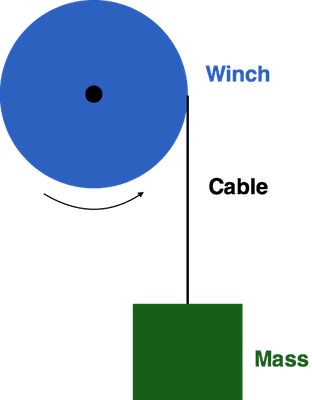
Materials Needed
Building the Winch Mechanism
- gear motor plus plastic brick adapter
- ¼” dowel rod
- 2 Technic friction axle pegs
- string
- quarter
- Laser Cut Winch & Motor Unit (see Teacher Materials)
Additional Materials for Using Two Winches
- gear motor plus plastic brick adapter
- 2 Technic friction axle pegs
- string
- object to move (small plastic animal or similar)
Building the Winch Mechanism
- You will need a motor unit for this lesson. You may have already built one. If not, you can use these instructions to assemble the motor unit kit.
- Next, use this video to assemble the parts in your winch mechanism kit.
- Attach the motor to motor port 1 on your Hummingbird board. Write a simple program to turn on the motor. Observe the movement of the winch and mass.
- Which direction of motor rotation (positive or negative) moves the mass upward?
- Which direction of motor rotation moves the mass downward?
Drawing a Free-Body Diagram
A free-body diagram is a drawing of all the forces acting on an object. Each force is shown as acting at the center of mass of the object (in this case, the center of the quarter).
- Draw a free-body diagram of the mass. What force pulls the quarter upward? What force pulls the quarter downward?
- Which force is larger when the mass moves upward?
- Which force is larger when the mass moves downward?
Using Two Winches
You can use a single winch to raise and lower a mass in the vertical direction. You can also use winches to move objects horizontally. This requires two winches.
- For the next part of this lesson, you will need two motor units with winches. You can make another winch mechanism, or you can team up with a neighbor!
- Connect the two winch mechanisms to motor ports 1 and 2 on your Hummingbird board.
- To move an object horizontally, one winch will need to release cable while the other winch retrieves cable. For example, for the snail in the video below to move to the left, the left winch must retrieve (wind up) cable while the right winch releases (winds out) cable.
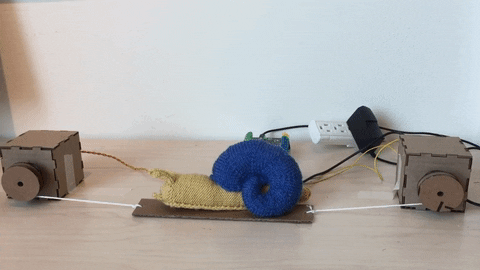
- Use a table like the one below to record whether positive or negative motor speed makes each winch retrieve or release cable.

- Tape the winch mechanisms to the table. Tie each cable to one end of a piece of cardboard. This forms a platform that you can use to move a small object back and forth.
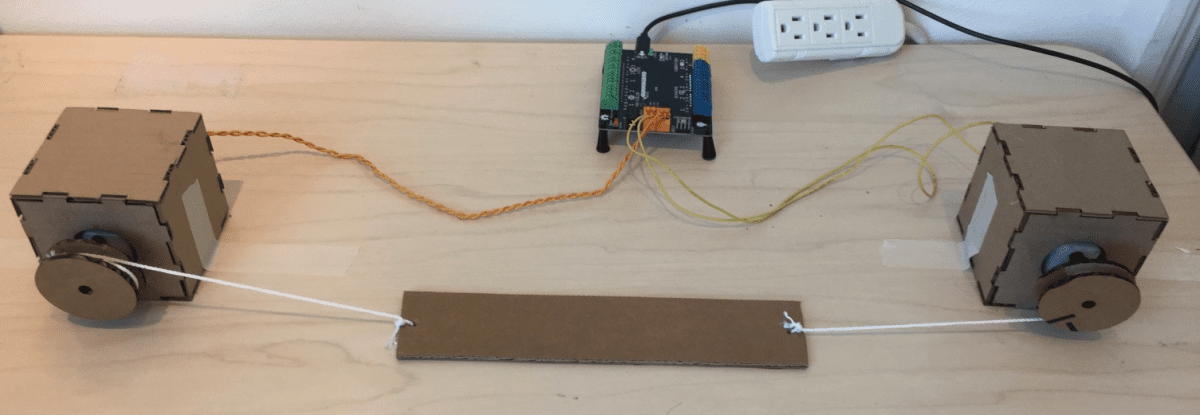
- Write a program that moves the platform slowly to the left by retrieving cable from one winch while simultaneously releasing it from the other.
- Write a program that moves the platform slowly to the right.
- Use a knob sensor to control whether the platform moves to the left or right.
Using Winches to Create Robots
A single winch can be used to move an object up and down, but a single winch can also move an object along an inclined plane. This video shows a model of Pittsburgh with a cable car moving up and down a hill.
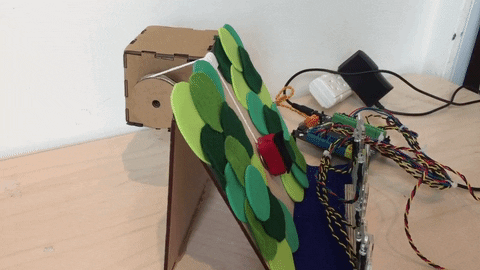
Two winches were used to create this biomechanical model of the knee. One winch represents the muscles that bend (flex) the knee, and the other represents the muscles that straighten (extend) the knee. To bend the knee, the flexor muscles muscles shorten while the extensor muscles lengthen. This is represented by the flexor winch retrieving cable while the extensor winch releases cable.

Now it is time to use winches to create your own robot! What linear movement do you want to create? How many winches do you need?
Finding More Information
- Winch: This website gives some nice real-world examples of winches.
